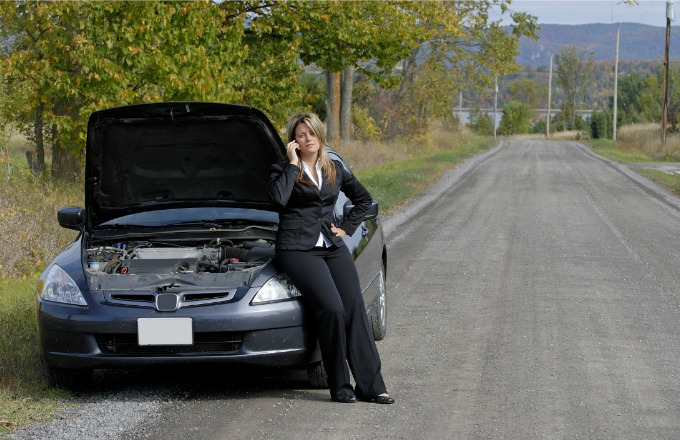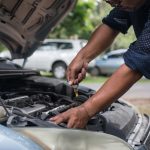Reasons Why Your Car Shuts Off While Driving

Driving while your automobile shuts off is a risky condition. This headache has a variety of causes. Find out the most common causes of automobile shut-offs, how to fix them and prevent them from happening again with regular car maintenance, and what to do to keep you and other drivers on the road safe when this happens while you’re stuck in traffic.
We’ll discuss the problem of car shutoffs while driving in this article. Compared to when your car switches off after you stop, this is a different situation. The most frequent causes of this, which occurs when the engine is extremely sensitive at idle, are a defective throttle body or a poor fuel mixture that is to blame for the very low idle.

Reasons Why Your Car Shuts Off While Driving
Faulty Crankshaft Position Sensor
A malfunctioning crankshaft position sensor is one of the most frequent causes of the problem when the car switches off while being driven. The crankshaft position sensor’s job is to keep track of all the moving parts of the engine, including the crankshaft, valves, and pistons. It keeps track of the crankshaft’s speed and position to help determine when fuel injection and ignition should take place.
To put it simply, this system is necessary for your engine to operate at its best. A cylinder will misfire if the crankshaft position sensor fails to give the Engine Control Unit the accurate information about where the pistons are located in the engine.
The check engine light may illuminate if the crankshaft position sensor is malfunctioning. The tachometer not functioning properly is another indication that the crankshaft position sensor is broken. The gauge on your dashboard that displays your car’s RPMs is called a tachometer and is normally placed next to your speedometer. Each time you crank your engine, the tachometer usually rises. The tachometer will remain in place once the desired speed is reached.
The ECU will then communicate information to the tachometer after obtaining data regarding engine speed from the crankshaft position sensor. Therefore, a defective crankshaft position sensor will transmit inaccurate and anomalous data to the ECU, It is subsequently sent, resulting in the tachometer acting unpredictably or inconsistently.
Engine control unit fault
A malfunctioning Engine Control Unit (ECU) or engine control module is another issue that could cause a car to shut off while in motion and flash the Check Engine light. The electronic control unit (ECU) in your car is a computer that gathers data from numerous internal combustion engine components to ensure that the entire system is operating optimally and precisely to maximize efficiency.
Your automobile may shut off and come back on at random due to unexpected drops in power, fuel economy, and spark loss caused by an erroneous ECU. A malfunctioning ECU might also cause your car to stall and jerk while you’re driving. On your dash, the check engine light can also come on.
It is not simple to test and examine your ECU, unfortunately. The presence of a check engine light does not always indicate an ECU issue. The only thing you can do if you want to try troubleshooting on your own is to utilize an OBD scanner to check what diagnostic issue codes you receive. It may still be unclear whether the code indicates a faulty ECU. The only thing you can do is take it to a qualified mechanic. A mechanic will be able to diagnose your ECU using the appropriate equipment, software, and knowledge.
Faulty Alternator
Your car’s alternator is in charge of generating a steady flow of electricity from the mechanical energy of the vehicle. These electrical components include the dash lighting, dome lights, air conditioning unit, stereo, etc. It also uses this electrical energy to charge the battery. Your car won’t receive the necessary electrical power if the alternator is malfunctioning for some reason, which can cause the issue of car shutting off while driving. When this occurs, your dash will begin to flash.
It’s crucial to remember that if your battery is healthy and capable of supplying electricity when your alternator fails, your car can continue to run for a while without one, which you might not immediately realize.
what you’re up against.
However, because the battery is not intended to power the complete automobile, your car can only run on it for a short time. Your car will stall and eventually shut off after your battery is dead.
When an alternator is malfunctioning, your automobile will start to receive inconsistent power, which should be detectable if you pay close enough attention to how it operates. Regardless, a simple DIY auto maintenance task is to test your battery and alternator on a regular basis—say, let’s every 4-6 months—using a multimeter or voltmeter.
Leave the engine running while turning off the stereo, all possible electrical accessories, including the dashboard lights, and the alternator itself. Use the multimeter to test the batteries. At constant idle speed, a healthy alternator should produce 13.1 to 14.6 volts. If not, you should have a specialist give it a closer look.
The alternator should next be tested to check if it will work properly under severe use. Allow your aide to maintain a 2000 RPM engine speed. Activate all of the vehicle’s components, including the wipers, radio, inside lighting, and headlights, and reconnect the voltmeter. The alternator is powerful enough if the voltage reading is 13.0 volts or higher. Any value below 13.0 indicates a defective alternator that has to be replaced.
Fuel tank empty and inaccurate fuel gauge
You might be shocked to learn that a lack of fuel causes thousands of people’s cars to shut off while they are driving each year. There are times when your gasoline gauge has gone defective and does not accurately reflect the actual fuel level in the tank, even if some people may be too busy or forgetful to check the fuel level frequently and refill at the earliest chance.
Failure of the sending unit is one of the frequent causes of defective gas gauges. Your fuel gauge will normally become stuck in one place as a result, usually at the “F” or “E” mark, regardless of the fuel amount.
If you believe your fuel may be malfunctioning to determine whether your car will start again, try adding 1 gallon or 4 liters of gasoline to the gauge or fuel level sensor.
Fuel system or pump that is clogged or defective
When your automobile abruptly restarts after turning off while you’re driving, a malfunctioning fuel pump is frequently at blame. In order for combustion to produce power, your engine needs a precise supply of fuel at an exact moment as an input. The fuel pump is the component that provides the engine with the appropriate amount of fuel. It is very similar to your car running out of gas when the motor shuts off if the engine does not receive the proper amount of fuel at the appropriate times. There is no bypass for a malfunctioning gasoline pump, which is bad news. It will need to be fixed or changed.
Your fuel filter being blocked is another potential cause. The fuel filter’s duty is to purify the fuel before it enters the engine. As old gasoline contaminates it over time, the fuel pump may be unable to pump enough fuel through it, which will interfere with the engine’s capacity to produce power and cause your car to shut off while you’re driving.
If your fuel filter is made of nylon or paper, you should just replace it because it is inexpensive. You may simply clean and reuse it if it’s made of metal.
The majority of fuel pumps are mounted within the fuel tank. Giving the fuel tank a kick with your foot is one easy approach to determine whether the fuel pump is actually to blame when your automobile shuts off while you’re driving. If the car starts at that point, your fuel pump most likely has a problem. The tank is composed of plastic, therefore do not bump it firmly with a metal object as you don’t want to break it.
Incorrect ignition switch
The ignition switch, which is positioned behind the ignition lock, is turned when you turn the key to start the vehicle. There are numerous microscopic metal plates that can corrode over time inside the ignition switch. When this occurs, one of these plates may break contact, cutting off the ignition as a whole. The system that regulates the quantity of power passing through them may also stop functioning if the ignition relay malfunctions. While driving, these will result in an abrupt engine shutdown.
Fortunately, it’s rather simple to determine whether a broken ignition switch is to blame for your automobile cutting out while you’re driving. Check to see whether your dashboard lights are still on after the car shuts off. It’s likely that the ignition switch is broken if the dashboard instrument is dead. After the car has stopped, try twisting the keys again while they are in the ignition. If the engine still won’t start, you probably have an ignition problem.
Faulty Spark Plugs

The small spark plugs are another essential component that enables your engine to produce power. In order to produce combustions, these are the components that ignite the air and fuel combination in the engine’s combustion chamber. Each spark plug in a cylinder is independent.
You can still start and operate your car if only one spark plug is damaged. Your automobile may start if more than one spark plug is bad, but it probably won’t drive very far. Your engine will stall and shut off while you’re driving if several spark plugs are damaged.
In most circumstances, there are other warning signals you should watch out for before your engine totally turns off and leaves you stranded, such as decreased engine performance, a lack of acceleration, engine misfires, and engine knocking.
If you experience any of these symptoms, finding and inspecting your spark plugs should reveal whether or not you have a bad one. Your spark plugs’ condition may be ascertained once you can view them in person. Any spark plug that has blisters from operating too hotly or that is covered in something like oil, fuel, or carbon is faulty.
Check out our next Article on what to do when your Car Shuts off.







